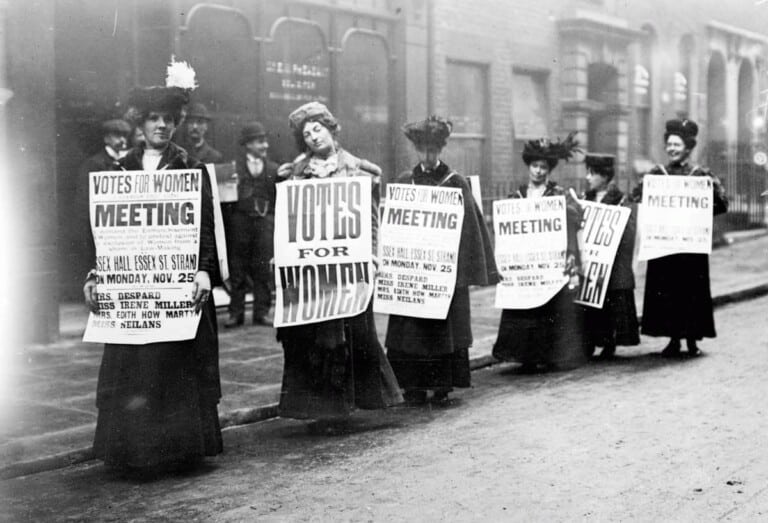Before the Industrial Revolution, men and women worked together as an economic unit, especially in rural communities. In well-off households, women would run the house.
The Industrial Revolution polarised women’s condition: the well-to-do withdrew from household management, leaving the way clear for the housekeeper. A woman was seen by the upper classes as an idealised creature, gentle, pure, and pious.
However, the ever more numerous working-class women would frequently work in factories. In 1851, 2.3m women and female children of working age out of 8m worked. Many women worked in service (1.2 million in 1881). Feminists disliked both these extremes.
Arguments against the franchise for women: women were disqualified by their sex; the franchise was based on property qualification; women were thought to be too emotional; most women did not need the vote (they were surrounded by men who often would have it).
For the rest, if vagrant and very poor men did not have the vote, then their women did not deserve it either; the “idealized” woman was above the dirty affairs of Parliament; female suffrage might well pose a threat to men’s sexual domination of women.
Women’s rights were limited if non-existent throughout the 19th century. Reforms were finally obtained after the perseverance of female/feminist activists.
The Custody Act of 1839 gave mothers custody rights of children under 7 in cases of divorce or separation; the Guardianship of Infants Act (1886) gave guardianship of children to mothers on the death of their husbands; the Married Women’s Property Acts (1870, 1882) gave married women the right to keep their own property or earnings.
The Queen’s College (1848) was founded to award degrees to women (elementary and secondary education became available from the 1870s onwards), and the Matrimonial Causes Act (1857) led to the setting up of a divorce court and the possibility of obtaining a divorce on specified grounds though they varied from men to women.
Women also began to have greater access to employment in shops, schools, offices, and the civil service from the end of the 19th century.
Susan Kingsley Kent (in Sex and Suffrage in Britain 1860-1914) describes the middle-class suffragist movement: she claims that far too many historians assumed it was exclusively political.
For her, it was more than that: the vote was the symbol of the sexually autonomous woman – female suffrage, therefore, meant opening the way to a transformation of the condition of women.
Martin Pugh (in Women and the Women’s Movement in Britain 1914-1959) however makes the point that late 19th century and early 20th century feminists were cautious reformers trying desperately to win support (especially from men) in a society hostile to women.
Jill Liddington and Jill Norris (in One Hand Tied Behind Us) mention the fact that many thousands of working-class North-West radical suffragists participated in the campaigns.
They were often part of the growing labour movement, often members of the Independent Labour Party. They felt that political enfranchisement preceded industrial enfranchisement.
However, they rarely left an indelible mark on recorded history in that they rarely wrote their memoirs.
The campaign for female suffrage lasted for many years and covered different phases :
1866-1870: the Petition presented by John Start Mill, in the context of the 2nd Reform Act, supported by Florence Nightingale, Elizabeth Garrett…
1870-1897: there was a possibility that the legislation prepared in 1884-1885 (3rd Reform Act) could include some measure of enfranchisement for certain women but it was opposed by, among others, Gladstone. Nevertheless, progress was made in other fields (education, the medical profession).
1897-1914: the creation of the National Union of Women’s Suffrage Society (NUWSS) in 1897 – the Suffragists – and of the Women’s Social and Political Union (WSPU) in 1903, under the autocratic control of Mrs. Emmeline Pankhurst and her daughters, of whom the most famous at this time was Christabel. The Cat and Mouse Act was passed in 1913.
1914-1918: World War I and the suspension of militant activity for the duration of the war and the pursuit of relief of distress, were accepted by the majority of female activists.
The Representation of the People Act (1918) granted the vote to women aged 30 and above. This enfranchised 8.4m women (compared to 12.9m men).
Women’s rights were still linked to wives’ rights (i.e. the status of women compared to men).
The NUWSS became the National Union of Societies for Equal Citizenship (NUSEC) with a wider remit.
In 1928, women obtained the right to vote on the same basis as men.
Synopsis » Inequalities in Great Britain in the 19th and 20th centuries
- Ante Bellum, Inter Bella : Legislation and the Depression
- Electoral inequalities in Victorian England: the Road to Male Suffrage
- Inequalities in Britain today
- Inequality and Gender
- Inequality and Race
- More electoral inequalities : the Road to Female Suffrage
- The Affluent Society : poverty rediscovered?
- The Beveridge Report: a Revolution?
- The Poor Law Amendment Act (1834)
- The Thatcher Years : the individual and society
- The Welfare State: an end to poverty and inequality ?
- Victorian philanthropy in 19th century England

